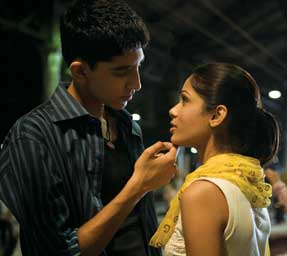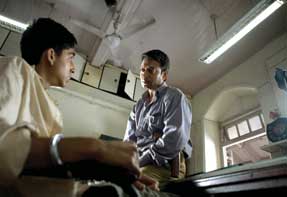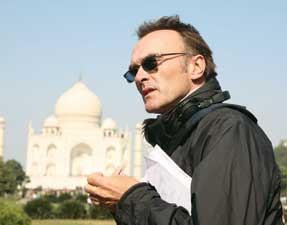Arts
A Million Slumdogs Now

Slumdog Millionaire is a brilliant, vile film that puts the pornography of poverty at the center of its universe.
|
Slumdog Millionaire arouses questions, admiration, disgust, repulsion, awards, debate, discussion, and widespread popular and journalist-critic reaction. Director Danny Boyle hit a jackpot with the film, which is generating attention as riveting as the film itself. And we are not quite done yet. After a sleepy start in just six major U.S. cities, the film caught the imagination of audiences in this country, expanded to 600 theaters by Christmas, swept four Golden Globes and 10 Oscar nominations, including one for best picture. Virtually every major newspaper in the country is buzzing with articles, reviews and commentaries.
The film is worth seeing. It may not leave you teary eyed or particularly elated, but, for better or for worse, it will provoke. It is a brilliant, vile film that puts the pornography of poverty at the center of its universe. Its realism appeals to the sensibilities of audiences weaned on Sally Struthers commercials for starving children and those wedded to a vision of India as a giant call center that will somehow transform into a superpower over the next few decades. It demonstrates what complete control over the film making process and narrative can make possible while also drawing from the clichés and improbable fate in Bollywood films. It is produced by a director who studied Bollywood cinema to deliver its best kernels to Western audiences. He reversed what Bollywood has been doing — imitating Western narratives and turning them into palatable stories. Slumdog Millionaire represents a new style of film making. The money and control belongs to one country, while the narrative, motifs and imagery belong to another. It is a new form of cinema that transcends national cinema — transnational cinema that crosses boundaries. The production standards of Slumdog Millionaire are superb. The film presents the realism of the locales, slums and all. It is based on the story of a young slum dweller, Jamal, who loses his mother to the brutal violence of anti-Muslim mobs (a clear reference to real events). His brother turns out to be a thug, but he grows older with love in his heart for his childhood friend and English (presumably learned at the Taj Mahal during a stint as “tourist guide”). Jamal jumps at the opportunity to take part in the TV program Kaun Banega Krorepati, popularly known to Westerners as Who Wants to be a Millionaire. He goes on to win the top awards, because the questions asked of him seem to match his own experience in the slums. The film is constructed as a series of flashbacks, moving back and forth in his life, concluding in a melodramatic fashion with Jamal, the slumdog, getting the girl. The film concludes with a Bollywood style dance at the Mumbai train station.
An almost all-English crew of director, scriptwriter, cinematographer use an almost all Indian (U. K. born, but Indian) cast, including Bollywood stars Irfan Khan and Anil Kapoor. The music is composed by A. R. Rahman, who became the first Indian to win a Golden Globe award (and whose name was mercilessly butchered in pronunciation by everyone on stage, including those who attempted to correct it). All is well that ends well and the film, despite its graphic depiction of poverty and brutality of circumstances and villains, leaves a good taste. A poor fella wins and visions of Horatio Alger begin to flash (see a particularly naïve piece by Anand Giridhardas in The New York Times). The film evokes images and stories from a world that is familiar, although not known, to Western audiences. The film is a fantasy in its content. Who wouldn’t want to believe that a slum kid could win millions by beating the system at a TV game? But it is also a fantasy for its Western audiences — it affirms the world the West lives. India has two distinct elements; poverty and call centers. There is the underworld of crime in between, but that is not entirely unrelated to the other two elements. The film’s narrative does not move between these two scenarios. And yet, the film is steeped in realism. Amitabh Bachchan fired a salvo on his blog that the film “projects India as a third world, dirty, underbelly developing nation and causes pain and disgust among nationalists and patriots, let it be known that a murky underbelly exists and thrives even in the most developed nations.” The retort from The rdian was sharp: “It must hurt him to be so monumentally upstaged by white folk on his home turf.” The rdian goes on to accuse Bollywood of ignoring “a third of the world’s poorest who are Indian” in its films, which the paper complains, appeal to and depict the fantasies of the middle class. Once the realism of reality hits the screen, Bollywood squirms. There is a gritty truth in this comeback against Amitabh Bachchan.
Slumdog Millionaire is doggedly realistic, even if it exaggerates and often misleads (torture at the police station by cops who are friendly one minute and gouging eyes out for begging, both practices, which, if they exist, have been missed by human rights groups). There is also the logic of improbability, which Bollywood loves (chance and fate bring narrative characters and elements together), but it is deployed in a cloak of clean, fast and tightly edited sequences, all features that both absorb and leave Bollywood’s mainstream cinema behind. That this realism is “poverty porn” (characterized by an even sharper critique of the film by Alice Walker in London’s The Times) should come as no surprise. Just as only an outsider, a Westerner, could have made a film like Slumdog Millionaire, only a Westerner looking at poverty in India (even though the story is adapted from the novel Q&A by an Indian, Vikas Swarup) could show the worst poverty in the best light, vetting the appetite for more. The Mumbai Mirror dubs it “slum chic,” but there is a tradition in Hollywood to recognize and salute such films (City of God from Brazil’s favelas e.g.). We want people to win in such circumstances, because we cannot stomach the pain any longer and before it attacks our conscience. What pulls the viewer of Slumdog Millionaire out of its pornographic disposition is its fast moving and slick narrative, a story with a sheer desire to reach a good ending. We will see a lot of films like Slumdog Millionaire in the coming years and decades. The façade of making films with strictly national context, with culture specific motifs, themes, etc. is already disappearing from world cinema. In fact, Bollywood itself has set some trends in this area, making films that cross boundaries. Vast networks of immigrant cultures around the world finance such films and support their circulation. As a result, we have seen immigrant characters and themes in Bollywood narratives. Besides, Bollywood has never shied from moving the visual drama to various continents around the world, thus turning film making and watching into intensely international experiences. The trouble with Slumdog Millionaire for many people is the fact that it was produced by Britishers, with “foreign” money, employing Indian actors and set in India. This kind of film making breaks the traditional concepts of national films, national cinemas and stories that belong to one people. It is an increasingly popular trend around the world and Danny Boyle’s intervention with Slumdog Millionaire may just launch that trend on the Indian sub-continent. Chandni Chowk to China, the first Hindi film venture by Warner Brothers Pictures, is now hitting U.S. theaters. There is a spate of other films being produced in India and the marriage of Dreamworks/Spielberg and Reliance/Ambani is expected to speed up the process. If Slumdog Millionaire wins the Oscar and builds on its success, it will only increase the appetite to not only “outsource” film making to India, but also produce similar films that defy the traditional definitions of “Indian” cinema. Therein lies the rub. Slumdog Millionaire is an “Indian” film in the sense that it borrows the narrative and aesthetic elements of Bollywood. It is set in India; it is more about Indians than some Bollywood films (which become more hybrid every year) and it makes us think of India. It raises problems that are “Indian.” And, the film, shot mostly in Hindi, has Indian actors (who are paraded at award ceremonies instead of its crew members to emphasize this point). But in a traditional sense, this is an abomination. The film about Mumbai was only released in India on Jan 23, a day after it was nominated for the Oscars. Indians had not seen it and the “foreign press” has not stopped wondering what Indians, particularly native slum dwellers, think of it. This gives new meaning to Indian-ness in Indian films. There will no doubt be a clamor for claiming genuine Indian-ness. The new age has arrived and Slumdog Millionaire seems to have knocked down the door more than Richard Attenborough’s Gandhi did some two decades ago. Yet, for Western audiences, the film has “foreignness” associated with it. If it is winning hearts in this country, it is principally because it appeals to the taste for “foreign” movies. The film critic A. O. Scott wrote in 2004 in The New York Times (“What is a Foreign Movie Now?”) that there are two kinds of foreign movies that win acceptance in the United States; the humanist type (mostly about the natives, set in the realist mode) and the modernist type (about middle class, city dwellers, reflecting on existential situations). Granted Slumdog is not exactly a “foreign” movie. The Academy prefers “foreign lange film,” an entirely dubious nomenclature. For the British Academy the category is more illustrative: “film made in lange other than English.” Nevertheless, it bears all the marks of a film made about another culture, and one that pretends to be “native” in its stylistic and narrative claims. Slumdog Millionaire is neither a humanist nor a modernist film, but it is a film that revives a “colonialist” approach to the other. Like all Sally Struthers commercials, the film is intended to make you feel good in the end. The good will triumph; the villains will be punished and the poor have a chance of making it on to the sunlit stage of wealth. Why would such a film fail? Finally, the film holds a potent political lesson for our times. Perhaps Danny Boyle and Co. have unleashed a series of insights on how to understand poverty and its relationship to success as we define it. What is “written” for the Slumdog is not his fate. That would be the liberal solution to the problems of bad times and recession; just wait for the tide to turn and get rid of the culprits who spoil the broth.
When we leave the task of fighting poverty to mere providence (a mark of most “Bollywood” narratives), we ignore what else is “written” in that scenario. There are hints in Danny Boyle’s work, but in the form of narrative commitment. Each of the victories of Slumdog is “written” on his history, the history of his body. We learned that this is where power leaves its lasting marks. The “solution” for this is not to wait for the luck of the draw or by seeking a lifeline or asking audiences for a bailout. The solution is a steady re-writing of that history. The pain on the body has to be re-written. One cannot wait for the answers to match fortuitously to the questions posed. One has to re-write the history written on the bodies by poverty and one has to, of course, force a re-phrasing of the questions. These are the issues re-opened by Slumdog Millionaire and such is the challenge for cinema made across borders. |




